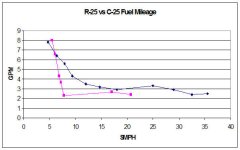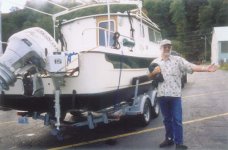Tom,
If you look at the vast majority of boat tests, as a boat speed increases, once it climbs over the bow wave, which is basically the defination of comming onto a plane, the miles per gallon decrease after a certain point. This point is considered to be were the boat is fully on a plane and is usually the most effecient speed. You are correct that seems to be little variation in many of these C Dories when they up on the higher speeds (you mention 24 to 31 mph)--but in the graphs in this thread, there is little difference between 3000 and 5000 RPM--that does not fit most other usual boat tests. I have about a dozen magazines in my room currently and they have about 35 boat tests amoung them. Typical is this
best speed--gives the best range and miles per gallon, and then gradually decrease in the upper ranges. Some are flatter in the upper range as you suggest, but none are flat like these curves in this thread.
Drag forces, include water resistance, wind resistance, wave making (eddy) resistance and any chop resistance, assuming anything but dead calm conditions. There are stepped hulls, hydrofoils and prop ridding boats which do have significantly less surface area.
See David Gerr's Nature of Boats.
For the Boat test.com (agree that they are optomistic)--
For the 22 with a 90 carburated Honda, the boat is on a plane at 14.2 mph and gets the best "mileage" of 4.51 mpg@ 3500 RPM. At 19.1 mph it drops to 3.81; 24.7 mph=3.55 mpg; 27.4 mph = 3.38 mpg, 30.9mph, =3.41 mpg, and at 32.9 mph (6100 RPM) = 3.45 mpg. Although the upper range is relitatively flat, there is a dramatic drop after the most effecient speed.
For the CD 25 with the 150 Honda: the best fuel economy occurs at 3500 rpm: 15.4 mph= 4.05 mpg; 18.7=3.6 mpg, 23.4mph = 3.71 mpg; 27.2mph=3.36; 31.3 = 2.85mpg; 32 mph = 2.44 mpg
In the graph above, Anna Leigh only gets 2.5 miles a gallon at 3500, where and then the miles per gallon increase to over 3.2 at 4000, and slt better at 4500 and 5000. Where as Daydream gets the 3.0 miles a gallon at 3000 RPM, and goes up to over 3.5 at 4500 and 5000 RPM. They do not show this one dramatic place where the fuel mileage is exceptionally better--and I suspect it relates to weight, engines, and propping of the various boats. Definately the Ranger tug shows a big hump--which is much less in the C Dory




